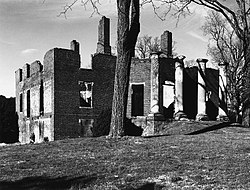Barboursville (James Barbour)
|
Barboursville
|
|

Barboursville ruin
(photo by United States Department of the Interior) |
|
| Location | S of jct. of Rtes. 777 and 678, Barboursville, Virginia |
|---|---|
| Coordinates | 38°09′44.55″N 78°16′50.48″W / 38.1623750°N 78.2806889°WCoordinates: 38°09′44.55″N 78°16′50.48″W / 38.1623750°N 78.2806889°W |
| Area | 0 acres (0 ha) |
| Built | 1822 |
| Architect | Thomas Jefferson |
| Architectural style | Neo-Palladian |
| NRHP Reference # | 69000267 |
| VLR # | 068-0002 |
| Significant dates | |
| Added to NRHP | November 12, 1969 |
| Designated VLR | September 9, 1969 |
Barboursville is the ruin of the mansion of James Barbour, located in Barboursville, Virginia. He was the former U.S. Senator, U.S. Secretary of War, and Virginia Governor. It is now within the property of Barboursville Vineyards. The house was designed by Thomas Jefferson, president of the United States and Barbour's friend and political ally. The ruin is listed on the National Register of Historic Places.
Until it burned on Christmas Day 1884, Barbour's house stood essentially as completed, c. 1822, from designs by Thomas Jefferson. Jefferson designed the house in the then fashionable Neo-Palladian style.
Only two one-story side porches appear to have been later additions. Though large in scale, the house contained only eight principal rooms, as the hall, drawing room, and dining room were two-story chambers. The entrance façade featured a projecting Roman Doric tetrastyle portico which covered the recessed front wall of the entrance hall. On the garden front, the walls of the octagonal drawing room projected into a similar portico, as at Monticello.
The octagonal dome which Jefferson proposed in his drawing was omitted during construction; it is uncertain whether the Chinese latticework railing which appeared in Jefferson's drawing around the base of the roof was ever installed. Although the dining room had no chamber over it, Jefferson indicated a faux window on the second floor level in order to keep the garden front symmetrical. This feature was omitted and consequently gave that side of the house an unbalanced appearance. There is little evidence as to the appearance of the original interior architectural trim.
...
Wikipedia


